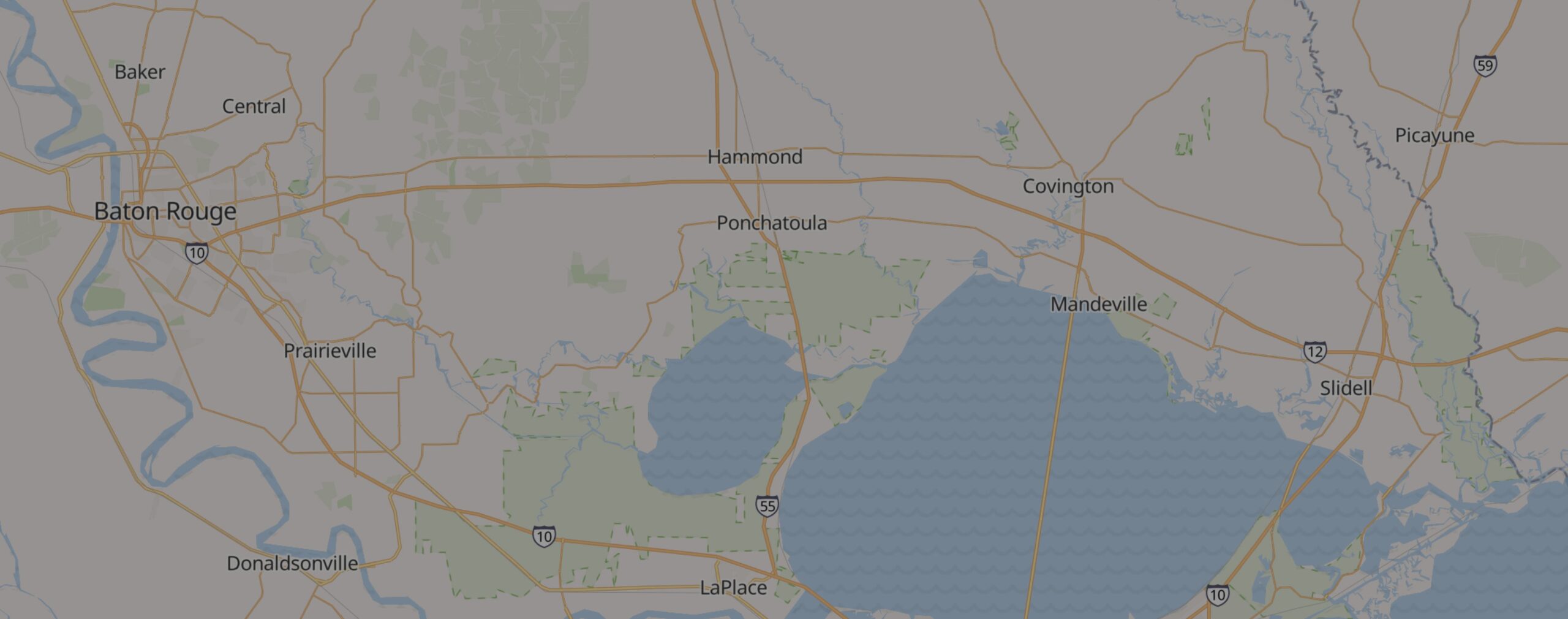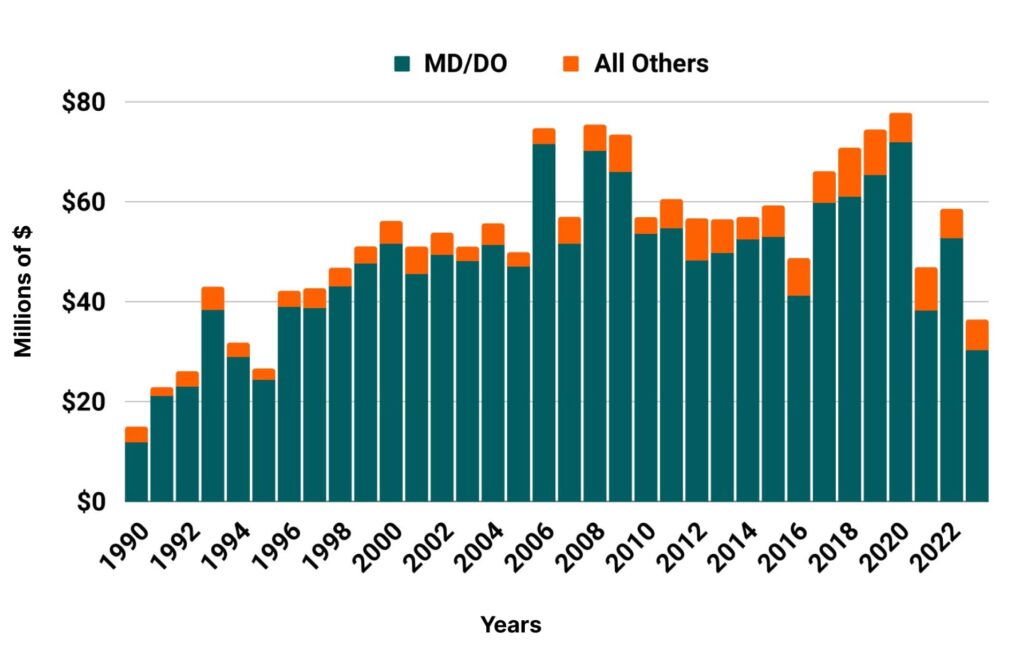Start Your Custom Quote Process™

Malpractice Insurance for Doctors & Physicians in Louisiana
Let our specialists compare medical malpractice insurance quotes for your practice in Louisiana
Our partners








Table of Contents
- Medical Liability Claims Trends for Louisiana Healthcare Providers
- How to buy medical malpractice insurance in Louisiana.
- How to save money on your malpractice insurance.
- How much does medical malpractice insurance cost in Louisiana?
- Medical malpractice requirements in Louisiana.
- Find Coverage for your Practice
- Client Testimonials
- Best medical malpractice insurance companies in Louisiana.
- Why partner with Cunningham Group in Louisiana?
- Historic medical malpractice insurance rates in Louisiana – since 2000.
- History of malpractice insurance in Louisiana.
- Resources for Physicians.
Louisiana Malpractice Insurance
Despite having passed comprehensive reforms to its medical liability system as early as 1975, Louisiana malpractice insurance rates tend to be high, especially when compared to neighboring states. Though Louisiana has a cap on damages and is one of the few states with a Patient Compensation Fund (PCF), malpractice rates have remained stubbornly high.
Our 2023 Physician Buyers Guide for purchasing malpractice insurance in Louisiana gives you the information necessary to obtain the strongest, most financially secure policy at the best price. When shopping for coverage, you need a full view of the Louisiana marketplace to find the company that best fits your situation. Choose a broker that can offer multiple quotes from all the major malpractice insurance companies in Louisiana.
Medical Liability Claims Trends for Louisiana Healthcare Providers
Louisiana NPDB from 1990 to 2023

How to buy malpractice insurance in Louisiana.
The best way to buy malpractice coverage is to work with a reputable malpractice insurance broker in Louisiana who can generate multiple quotes. Your broker will walk you through the lengthy insurance application and underwriting process. . Click to get medical malpractice insurance quotes from every major Louisiana malpractice insurance company.
Typically, the malpractice insurance purchasing process goes like this:
- Submit your information for your free medical malpractice insurance quote from every major insurance company in Louisiana.
- One of our veteran malpractice insurance agents who specializes in the Louisiana market will contact you to learn more about your specific needs.
- We shop your coverage to every major insurance company in Louisiana.
- We present you with a number of insurance quotes and give you the information necessary to make an educated and informed decision. Don’t worry. We’re here every step of the way, helping you get the best price with the best company.
- At renewal time, we restart the process of shopping your coverage among every major carrier to keep your policy properly priced.
How to save money on your malpractice insurance.
- The easiest way to save money on your medical malpractice insurance policy is by working with a broker who has the access to generate quotes from every major insurance company, offering an accurate view of the marketplace. As one of the top brokers in Louisiana, we can guide you through the application and underwriting process so you’re confident you secured the best price with the right insurer for your situation.
- The most common limits in Louisiana are $1 million/$3 million. Limits of liability play a major role in determining the overall cost of your policy. Some companies will offer lower limits to save you money. We don’t recommend this. We want your risks fully indemnified so you never have to pay an award out of pocket. Let us save you money by shopping your coverage rather than skimp on protection.
- Check out our 7 secrets your medical malpractice insurance agent won’t tell you page to get insider information on buying coverage in Louisiana.
How much does medical malpractice insurance cost in Louisiana.
Rates for physician malpractice insurance vary depending upon where you practice within the state. The cost of malpractice insurance in Louisiana also varies greatly depending upon which medical malpractice insurance company you choose. For example, a general surgeon in New Orleans could see an annual malpractice premium of $35,000. That same general surgeon could move his medical practice to Shreveport (Bossier Parrish) and see their malpractice premium drop to $17,000. This is one of the many reasons it’s important to work with an insurance agency that specializes in medical malpractice insurance. Below are mature, base rates with no credits or discounts. We typically get our clients a 30-50% reduction from these rates:
Louisiana
- Internal Medicine Average Rate $13,449
- General Surgeon Average Rate $43,774
- OB/gyn – Average Rate $43,529
Other Specialties
The cost of your malpractice coverage can vary greatly due to a number of factors, including your claims history, the type of patient interactions you have, the insurance company you are placed with and more. Cunningham Group created this premium estimation tool by drawing from its database of thousands of physician clients. Below are five malpractice estimation premium buckets to gauge how expensive your coverage should be. The buckets are numbered 1 to 5 — with #1 being the least expensive and #5 the most costly.
- Lowest
- Low
- Medium
- High
- Highest
Medical malpractice requirements in Louisiana.
Limits of Liability: The most common limits of liability in Louisiana are $100,000 per claim with an annual aggregate cap of $300,000.
Most hospitals require a physician carry malpractice insurance prior to granting admitting privileges. Some of the hospital systems requiring this include, but are not limited to, Ochsner Medical Center in New Orleans, Willis-Knighton in Shreveport and Our Lady of the Lake Regional Medical Center in Baton Rouge.
Find Coverage for your Practice
-
Individual Physicians
Learn MoreFind peace of mind for your practice. Allow us to locate suitable malpractice coverage from top providers, offering multiple quotes for your convenience.
-
Tail Coverage
Learn MoreSecure your future with Tail Insurance. Protect yourself from past claims with extended liability coverage—multiple quotes to match your needs.
-
Medical Directors
Learn MoreLead confidently with comprehensive malpractice coverage. We specialize in finding tailored plans from various providers for medical directors like you.
-
Telemedicine Coverage
Learn MoreNavigate the virtual frontier with confidence. We help find comprehensive malpractice coverage for telemedicine practitioners, offering multiple quotes.
-
Moonlighting Coverage
Learn MoreMoonlight with confidence when you have the right protection. Get various malpractice coverage options, ensuring you’re covered wherever you practice.
-
Surgeons
Learn MoreLet us identify the ideal malpractice coverage from top providers so you can focus on excellent surgical outcomes.
-
OBGYNs
Learn MoreSecure specialized malpractice coverage for women’s health. We provide tailored solutions with multiple quotes to meet the specific needs of OBGYNs.
-
Dermatologists
Learn MoreProtect your dermatology practice confidently. We specialize in comprehensive malpractice coverage, delivering multiple quotes so you can choose the one that matches your needs.
Client Testimonials
Below is what a few clients have to say about our prices and service. We know that cost and trust are the two most important factors when shopping for your medical malpractice insurance. We pride ourselves at being the best at both!
OB in LouisianaTim, thank you for the insurance cover. You were really helpful and prompt in the dealings and had answers to all my questions which were a lot. I thoroughly appreciate your guidance and the patience with which you helped.
Best Medical malpractice insurance companies in Louisiana.
- LAMMICO
- Medical Protective
- Columbia Casualty Co.
- NORCAL
Why partner with Cunningham Group?
Partnering with Cunningham Group will give you a full view of the Louisiana marketplace.. Our veteran insurance agents average 10+ years of industry experience. Let us help you secure medical malpractice insurance quotes from every major insurance company in Louisiana.
Historic Medical Malpractice Insurance Rates in Louisiana for Physicians.
Brief History and other important facts of medical malpractice insurance in Louisiana.
Despite having passed comprehensive reforms to its medical liability system as early as 1975, rates in Louisiana tend to be high, especially compared with neighboring states. Though Louisiana has a cap on damages and is one of the few states with a Patient Compensation Fund (PCF), malpractice rates have remained stubbornly high. Much of this may be due to the state’s overall tort climate, which, according to the Institute for Legal Reform (ILR), is one of the nation’s worst. The ILR, an affiliate of the U.S. Chamber of Commerce, ranked Louisiana as 49 out of the 50 states in its 2019 report, Ranking the States: A Survey of the Fairness and Reasonableness of State Liability Systems. Louisiana ranked at or close to the bottom in every measure, including judges’ impartiality and competence; jury fairness; damages; treatment of scientific and technical evidence; timeliness of summary judgment or dismissal; and having and enforcing meaningful venue requirements. New Orleans and Orleans Parish were also singled out as among the worst jurisdictions in the country for tort cases.
Louisiana Patient Compensation Fund
Medical liability reform came to Louisiana early on, with the passage of the Louisiana Medical Malpractice Act (LMMA) of 1975. The Act came in response to the medical liability crisis of the early-1970s, which saw the rate of claims more than double nationwide, leading to double-digit rate increases in physician premiums. The LMMA attempted to combat this trend through a three-pronged approach, including: 1. A $500,000 cap on total damages in medical malpractice cases (not including future medical costs); 2. The establishment of a Patient Compensation Fund, which provides for claim payments in excess of $100,000, up to the $500,000 damage cap; and 3. Creation of a medical review panel, comprised of three healthcare professionals and one non-voting attorney. The panel must determine whether a defendant acted within the appropriate standard of care and, if not, the panel must provide an opinion on whether or not the defendant’s actions contributed to the injury. The panel’s report is considered expert testimony and may be presented at trial.
Physicians and healthcare providers must meet certain requirements to be protected by the LMMA and participate in the state’s PCF. Physicians must carry at least $100,000 in primary insurance coverage from a traditional insurer – or self-insure by posting a $125,000 security bond – and pay a surcharge to the PCF. The PCF pools the risk of claims in excess of the required $100,000, so that the plaintiff’s total possible recovery is $500,000 plus future medical costs, which are paid by the PCF as they are incurred.
Louisiana has also reformed its joint-and-several liability laws to make defendants liable for only their share of damages and added a fee requirement when requesting that a case be reviewed by the medical review panel to help weed out frivolous claims. In 2006-07, a strong challenge to Louisiana’s damage cap was raised when the Third Circuit Court of Appeals ruled the state’s damage cap to be unconstitutional, as it was not indexed for inflation and did not provide an “adequate remedy” for those injured by a healthcare provider with medical damages in excess of $500,000. However, the Louisiana Supreme Court voided the decision on procedural grounds. In 2011, Louisiana legislatures attempted to pass a bill, known as SB 61, which would have secured the damage cap going forward by amending the state constitution to give the legislature the explicit power to “determine limitations on liability damages in medical or health care liability claims and other claims against healthcare providers.” Though SB 61 died in committee, the state’s damage cap remains in place for now.
Resources for Louisiana Physicians.
Louisiana State Medical Society
Medical Malpractice Insurance Guide
Louisiana Department of Insurance
Louisiana State Board of Medical Examiners
Louisiana Osteopathic Medical Society
Louisiana Medical Group Management Association
Physicians’ Health Foundation of Louisiana
All MD Louisiana Healthcare Defense Attorney Listing
